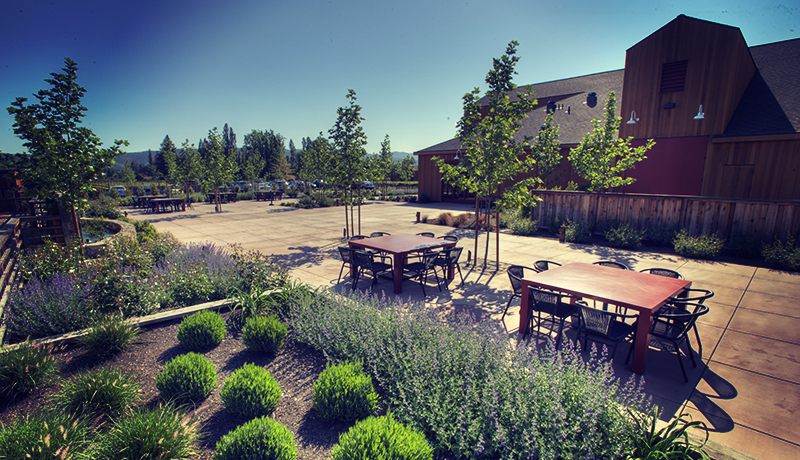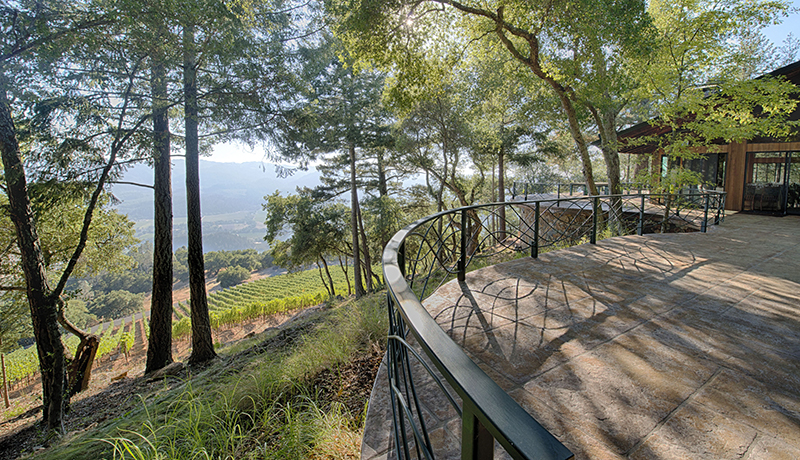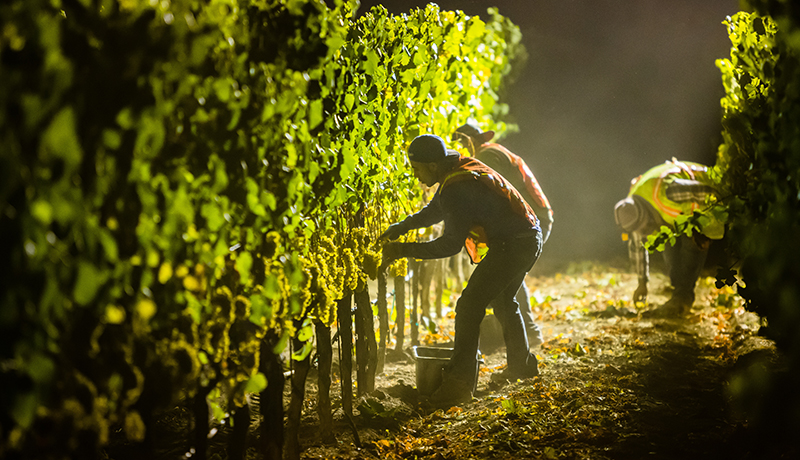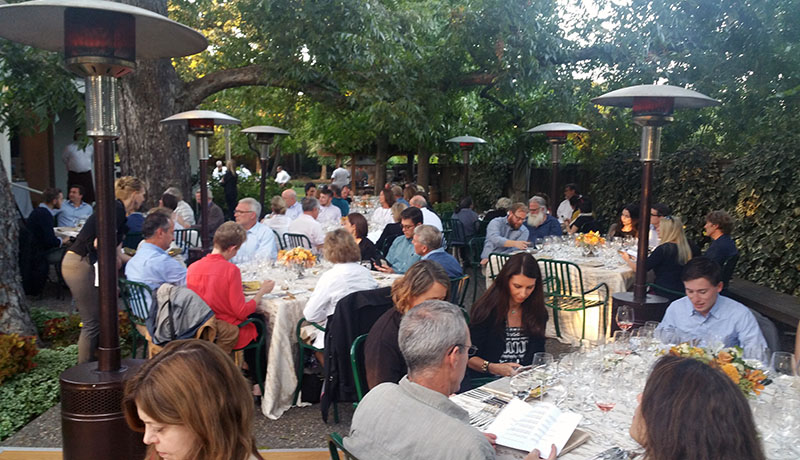

Cakebread Cellars, Photo Credit: Terry McCarthy
When you hear how Jack Cakebread stumbled into the wine industry, you can’t help but smile: In the 1970s, Cakebread was an amateur photographer on assignment in Napa when a coffee shop meeting with friends led to the purchase of a 22-acre plot.
After you realize that it has taken two generations (Cakebread, his wife, Dolores, and two sons, Bruce and Dennis) of love, sweat and shears to get the Cakebread Cellars label to the global prominence it finds itself today, you’ll get inspired.
But it’s not until you fully understand Cakebread Cellars’ love affair with food that you become hungry.
Most of the credit goes to the matriarch, Dolores, for the company’s culinary curiosities. A California native who’s always loved cooking and gardening, she set up a small bed of vegetables just as the winery was taking root itself. What started with a few greens has grown into a one-acre cornucopia of cucumbers, peppers and leeks nearly as impressive as anything you’ll see at Cakebread’s 14 vineyards.
Dolores was never one for keeping the spoils of her soil to herself. On the contrary, almost from the label’s birth, she showed an eagerness to teach people how to pair food with fine vino.
Cakebread Cellars brought in Brian Streeter more than 25 years ago to help Dolores’ dreams come to fruition. As the winery’s longtime executive chef and culinary director, Streeter ensures dinners at Dancing Bear Ranch or cooking classes on the main campus are mentioned in as high esteem as the latest vintages.

Dancing Bear Ranch, Photo Credit: Cakebread Cellars
Streeter also happens to be behind Cakebread’s successful American Harvest Workshop series. A four-day annual fete, AHW is a vital Napa occurrence — and we’re not just speaking as fans of Cakebread Cellars’ smooth sauvignon blanc, either. Through workshops, tastings and tours, this gathering is an exceptional way for the region to show it can produce goods other than great grapes.
Forbes Travel Guide tagged along for the 30th anniversary of the workshop in 2016. We assumed we’d see how Cakebread Cellars’ prized fruit were plucked from the vines. We thought we’d stop by an apiary or even get a little dirt under our thumbs at a garden. But as we soon came to find out, there would be much more cooked up.
Streeter and the Cakebreads have been organizing these events since the late ’80s, so figuring out how to properly schedule all of the eating, harvesting and cooking was nothing new for them. They essentially handled everything. All you needed to pack were an open mind and a good pair of walking shoes.
Fees cover your tours, wine sampling and cooking experiences. Overnight accommodations are dealt with separately, but with brilliant options such as Forbes Travel Guide Four-Star Bardessono Hotel and Spa, Four-Star Solage, An Auberge Resort and the adorable Napa Valley Lodge all within a 20-minute drive from the winery, that part of the trip proves a breeze, too.
Cakebread Cellars has worked with hundreds of chefs and purveyors from around the country over the past three decades. As the label has traveled around, strengthening distribution deals for its pours, it’s also kept an eye out for hungry, ego-free toques willing to spend a few days in the kitchen teaching newbies the joys of fig salami and malfatti (Swiss chard and ricotta dumplings). And that’s one of the most exciting aspects of AHW — the side-by-side cooking sessions.

The Art of Grape Picking, Photo Credit: Cakebread Cellars
Rubbing elbows at the same stove with other chefs and everyday people wouldn’t work with every cook, but Andrew Adams (Memphis’ Acre), Austin Fausett (Washington, D.C.’s Proof), Adrienne Grenier (Fort Lauderdale’s 3030 Ocean), Meredith Manee (San Diego’s 1500 Ocean at Hotel del Coronado) and Todd Hall jumped at the opportunity to partner with the winery.
Forbes Travel Guide was paired with chef Hall, a burly, firm-talking gent who, ironically, handled avocados and lotus roots like newborns. We chatted about him working at L’Auberge de Sedona. We discussed his new endeavor, Suegra Tequila Cantina, opening in Tampa this spring. But mostly, we just shadowed Hall everywhere, doing our best to steal even a drop of his vast culinary knowledge.
AHW field trips were eye-opening (and palate-pleasing) experiences for chefs and “sous chefs” alike. We stopped by Bellwether Farms, a family owned creamery that produces award-winning yogurts and cheeses from East Friesian sheep right in the heart of Sonoma County. Once you see the inner workings of the dairy and understand how serious the crème fraîche business is, you’ll laugh at yourself for not knowing how important livestock was to wine country.
Gourmet Mushrooms Inc. is another respected name across the country, but it’s nonetheless remarkable thinking that maitakes, alba clamshells and trumpet royales grow just a few miles over from red grapes. When a company representative pointed to a budding forest of nameko mushrooms, you almost see the joy come over a guest’s face while, at the same time, chef Brian Streeter stands over to the side with a didn’t-I-tell-you-wine-country-was-special kind of smirk.
If you’re lucky, one of your workshop days will also call for a stop at Della Fattoria bakery. If you approach the Petaluma, California, operation looking for some sterile factory where workers mindlessly knead dough, you’ll never find it; instead, you’ll spy a 150-year-old building surrounded by a courtyard dotted with whimsical lighting, quirky furniture and rollicking chickens.
Inside this colorful theater of flour, Edmund and Kathleen Weber’s team moved about like trained acrobats, dancing around tables and brick ovens, creating deliciously simple loaves that go to restaurants throughout Napa and San Francisco almost daily. (Fun fact: Five-Star The French Laundry was Della Fattoria’s second account ever.)

Harvest Dinner, Photo Credit: DeMarco Williams
The breads, mushrooms and cheeses weren’t merely for showing off the Bay Area’s bounty, though; they were ingredients used to prepare dinners for special invited guests. In some hands-on classes, “prepare” might be defined as cutting up carrots or garnishing a few plates. Not at the American Harvest Workshop. Chef Hall had us on the grill and at the meat slicer.
There were times we could almost hear servers tapping their toes, waiting on courses to be completed. When our shift ended, our smudged apron had quite the story to tell. It was all such a whirlwind of stress, fun and beautiful aromas.
Guest chefs orchestrate two meals. Workshop participants can elect to help out with one of them and rest during the other. We tied on the hair net both times because we weren’t sure how many more moments we’d ever have to learn the proper way to flip salmon on an open flame.
And honestly, being behind the scenes also affords you the best chance to sample a few extra glasses of 2012 Cakebread Cellars merlot without being judged by anyone.
